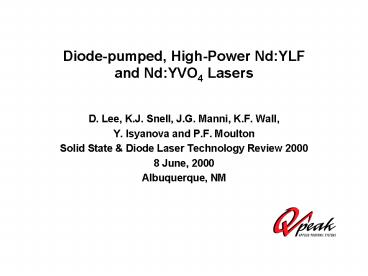Diodepumped, HighPower Nd:YLF and Nd:YVO4 Lasers - PowerPoint PPT Presentation
1 / 33
Title:
Diodepumped, HighPower Nd:YLF and Nd:YVO4 Lasers
Description:
Q-Switched, Nd:YLF, Master Oscillator (20-W pump lasers) ... MPV Nd:YVO4 MOPA System. 5 Gain Modules; 1 Oscillator, 4 Power Amplifiers. ... – PowerPoint PPT presentation
Number of Views:307
Avg rating:3.0/5.0
Title: Diodepumped, HighPower Nd:YLF and Nd:YVO4 Lasers
1
Diode-pumped, High-Power NdYLF and NdYVO4
Lasers
- D. Lee, K.J. Snell, J.G. Manni, K.F. Wall,
- Y. Isyanova and P.F. Moulton
- Solid State Diode Laser Technology Review 2000
- 8 June, 2000
- Albuquerque, NM
2
Outline
- Laser materials choices
- Basic NdYLF laser design and performance
- Basic NdYVO4 laser design and performance
- MOPA systems
- Applications
3
Three Nd Laser Hosts As Choices
4
MPS Pumping Design
5
MPS gain module with resonator (MPS-1047)
6
Production data on MPS gain module
7
MPS Q-switching produces high powers
8
CW oscillator performance scales upward
9
TEMoo properties are power-independent
10
Q-switched average power is nearly doubled with
50 more pump power
11
Higher gain yields shorter pulses
12
Peak power is increased at high PRR
13
High-power, MPV (NdYVO4) gain module
14
MPV (NdYVO4 ) Oscillator CW Efficiency
16
14
12
10
Output Power (W)
8
6
4
2
0
0
10
20
30
40
Pump Power (W)
- 1064 nm, gt15 W multimode, gt13 W TEM00, 46.3
slope, 35.0 optical and 13 electrical
efficiency. - 1342 nm, gt6 W TEM00, 26 slope, 15 optical and
6 electrical efficiency.
15
MPS CW Amplifier Performance
- Gain of 17 with 27 mW input at a pump power of
38.7 W. 3-pass small signal gain gt30 based on
later single-pass measurements.
16
MPS and MPV pulsewidth vs. rate
17
MPS MOPA system 2 generates 50 W cw
2nd Stage Amplifier
Cylinder lens
50 W CW 40 W Q-Sw _at_ 5 kHz 14-ns pulsewidth
1st Stage Amplifier
Two-module NdYLF Oscillator
EO Q-switch
Cylinder lens
18
MOPA 2 laser head
19
MOPA design allows scaling to 60 W cw
(20-W pump lasers)
28 W
50 W QS _at_ 5 kHz 60 W cw
40 W
18 W
11 W
10 W
QS
Isolator
Q-Switched, NdYLF, Master Oscillator
Gain Module
Relay Optics
QS
Mirrors
AO Q Switch
20
MOPA generates 54 W cw with one amplifier
(40-W pump lasers)
21
MPV NdYVO4 MOPA System
AO
Amp4
Amp1
Amp2
Amp3
Isolator
Osc
Output
- 5 Gain Modules 1 Oscillator, 4 Power Amplifiers.
Same design for both 1064 nm and 1342 nm. - Relay-imaged between master oscillator and
amplifiers to preserve optimum beam size
throughout the MOPA chain.
22
NdYVO4 MOPA Results
- 1064 nm
- Outputs CW/Q-Switched _at_ 50 kHz
- Oscillator 11.4 W /10.5 W, 10 ns FWHM
- Output 53.5 W / 50.7 W, 10 ns FWHM, 1.01
mJ/pulse 101.4 kW Peak - 200 W pump power ? gt25 optical, gt10 electrical
efficiency. - 1342 nm
- Outputs CW/Q-switched _at_ 50 kHz
- Oscillator 11 W /9.6 W, 22 ns FWHM (Double
crystal) - Output 26.5 W / 25.0 W, 22 ns FWHM, 0.5 mJ/pulse
- 23 kW Peak
- 240 W pump power ? 10.4 optical, 4 electrical
efficiency.
23
NdYLF harmonic conversion generates high
visible, UV powers (with Ushio)
5HG CLBO
4HG CLBO BBO
SHG (523.5 nm) 30 W at 67 kHz and 60-68
conversion in LBO 3HG (349 nm) 6 W at 10 kHz
(30) 15 W at 5 kHz in LBO 4HG (262 nm) 10 W
at 5 kHz with CLBO 2.5 W at 10 kHz in BBO 5HG
(207 nm) 2 W (internal) at 5 kHz with CLBO
SHG LBO
Oven
3HG LBO
24
MPS-based 349-nm commercial product
349 nm
6 Watt
NdYLF Oscillator
Amplifier Gain Module
THG LBO
SHG LBO
1047 nm
20 Watt
A/O QS
1047 nm and 523 nm
25
Schematic of RGB OPO
26
Watt-level doubled OPO outputs at 10 kHz
27
IR parametric oscillator systems
Intracavity OPO
1 W output at 1507 nm 12.5 kHz PRR 6 ns pulsewidth
Gain module
KTA 25 mm
NdYLF slab
AO Q-switch
Diode Laser bar
External OPO
43 conversion to 1507 nm
5 kHz PRR
28
Tuning curve for MPS-driven KTA OPO
29
Tandem OPO design gives full IR coverage
1.5 - 3.6 mm
Angle-Tuned
NCPM
KTA OPO
CdSe OPO
3 - 12
m
m
- Results to date
- (At 4 kHz pulse rate, 30-W pump power)
- KTA signal at 1514 nm 6.5 W
- KTA idler at 3450 nm 5 W
- CdSe signal at 5120 nm threshold
- CdSe idler at 10570 nm threshold
30
MPS modules amplify a mode-locked laser
0.7 W, 4.5 ps _at_100 MHz
(Modules pumped by 20-W bars)
31
Amplified ML laser converts efficiently
Second Harmonic Crystal
Fourth Harmonic Crystal
Amplified ML laser
CPM CLBO
NCPM LBO
8.4 W at 523.5 nm M2 lt 1.1
15.0 W at 1047 nm M2 lt 1.1
2.9 W at 262 nm
32
MPV amplifies a micro-chip laser
HR mirror
Faraday rotator
3 mW at 2 kHz, 400 ps pulsewidth
650 mW
MPV gain module
NdYAG / CrYAG microchip laser at 1064 nm
NCPM LBO SHG
390 mW, 2 kHz PRR at 532 nm
33
Summary
- Side-pumped NdYLF MPS and NdYVO4 MPV designs
combine simplicity, scalability of side pumping
with the high-efficiency, TEM00-mode performance
of fiber-coupled, end-pumping designs. - Recent availability of 40-W bars has more than
doubled the output of MPS NdYLF gain module to
gt 25 W and increased peak power at high pulse
rates. NdYVO4 performance may improve as well,
but strong thermal lensing will be a challenge. - CW-pumped, Q-switched systems can efficiently
drive nonlinear optics to generate tunable,
vis-UV and IR wavelengths. - Systems designers should consider cw-diode-pumped
systems instead of pulsed-pumped systems for cost
and reliability reasons.































